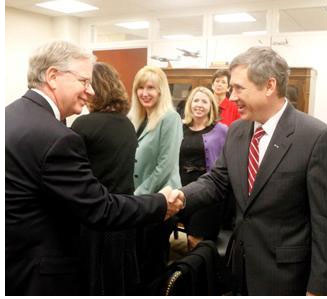by Crystal Ward
 I am pleased to introduce Alison Knopp, Development & Public Relations Associate here at Easter Seals DuPage and the Fox Valley Region, as a guest blogger today.
I am pleased to introduce Alison Knopp, Development & Public Relations Associate here at Easter Seals DuPage and the Fox Valley Region, as a guest blogger today.
Striving toward independence
by Alison Knopp
This year, Easter Seals DuPage and the Fox Valley Region partnered with senior photography students from the College of DuPage for the 12th Annual Photography Exhibit. This year’s theme was “Striving Toward Independence” and the photographers did an amazing job of capturing the joys and accomplishments of all 21 featured families.
Four children with autism were able to participate in the exhibit this year and each of their stories were captured in a unique and beautiful way.
Ten-year-old Traven was born at 28 weeks and spent the first year of his life in the NICU, ventilator, oxygen and feeding tube-dependent. Traven was also diagnosed with autism, and his family turned to Easter Seals DuPage and the Fox Valley Region for help. Thanks to the patience and dedicated hard work of his feeding therapist, Traven now understands his mouth, tongue and swallowing and is willing to eat a variety of foods. His independence is captured in his photograph which featured him riding a horse on his own.
Brothers Matthew and Benjamin also had a great time posing and smiling for the camera. Matthew was diagnosed with PDD-NOS at age three and received occupational therapy to help him improve his attention span, handwriting, self-help and social skills. Benjamin was diagnosed with autism at age three and has been receiving both occupational and speech therapy. He is more independent due to increased communication skills, self-help skills and confidence.
Ben, a fun loving, silly and energetic nine-year-old is on the Autism spectrum and has been receiving services at Easter Seals for many years. Through all of his hard work, Ben is currently able to read, do math, sit appropriately in class, dress and shower independently, make friends and communicate daily. He can be seen in his photograph running and playing in his favorite yellow shoes!
We are so proud to feature each of these families this year and highlight their amazing progress toward independence. To view the entire exhibit, check out the 12th Annual Photography Exhibit on the Events page of our website.
 We were so pleased to hear that the Ventura County Star in California featured photos of 10-year-old Gabriel Moraga with the Titans Water Polo Club in a photo gallery in their paper. Gabriel has autism, and he learned to swim through a program at Easter Seals Tri-Counties when he was 8 years old.
We were so pleased to hear that the Ventura County Star in California featured photos of 10-year-old Gabriel Moraga with the Titans Water Polo Club in a photo gallery in their paper. Gabriel has autism, and he learned to swim through a program at Easter Seals Tri-Counties when he was 8 years old.






 Once again this year
Once again this year 
 I was lucky to be among the 300+ Easter Seals volunteers, staff and families from across the country who visited Capitol Hill last week to deliver a very important message on early intervention. We asked every Member of Congress to invest more in young children with disabilities, delays and autism. And carried with us a
I was lucky to be among the 300+ Easter Seals volunteers, staff and families from across the country who visited Capitol Hill last week to deliver a very important message on early intervention. We asked every Member of Congress to invest more in young children with disabilities, delays and autism. And carried with us a